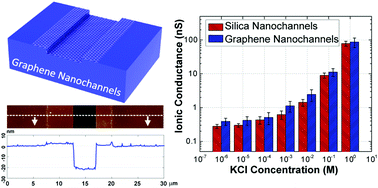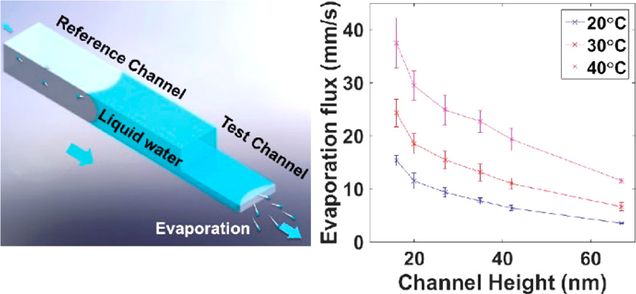Finished Projects
Finished Project I: Nanofluidic Diode
Ion and molecule transport control plays an important role for developing integrated micro-nanofluidic systems for biomedical applications. Here we demonstrated a nanofluidic diode that only allows ion flow in one direction. This nanofluidic diode was successfully realized by patterning positive charged protein (avidin) onto a biotin (electrically neutral) coated nanochannel using a diffusion-limited patterning technique. Under a forward bias, both cations and anions are accumulated in the center of the channel, resulting in significantly enhanced ion transport. While under a reverse bias, cations and anions were driven away from the center, forming a depletion regime and inhibiting ion movement. Our experiments suggest that nanofluidic diodes or other devices based on similar principles could find applications in control of pH and ionic concentrations and separation processes.
Ref:
1. R. Karnik, C. Duan, K. Castelino and A. Majumdar, “Rectification of Ionic Transport in a Nanofluidic Diode”, Nano Letters, vol. 7, pp. 547-551 (2007).
2. R. Karnik, K. Castelino, C. Duan and A. Majumdar, “Diffusion-Limited Patterning of Molecules in Nanofluidic Channels”, Nano Letters, vol. 6, pp. 1735-1740 (2006).
Schematic Diagram of a Nanofluidic Diode Diode I-V Characteristics
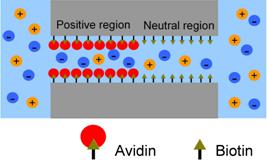
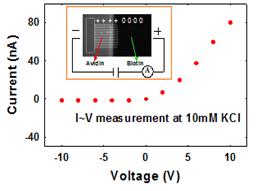
Finished Project II: Label-free Enzyme Sensor
我们
Ref: C. Duan#, MA. Alibakhshi, DK. Kim, CM. Brown, CS. Craik, A. Majumdar#, “Label-Free Electrical Detection of Enzymatic Reactions in Nanochannels”, ACS nano, vol. 10 (8), pp 7476-7484, (2016).
Finished Project III: Power Generation from Salt Gradient in Ion selective Nanochannels
Wh
Ref: D. Kim*, C. Duan*, Y. F. Chen, and A. Majumdar, “Power Generation from Concentration Gradient by Reverse Electrodialysis in Ion-Selective Nanochannels”, Microfluidics and Nanofluidics, vol. 9, pp. 1215-1224, (2010).
Maximum Power Output
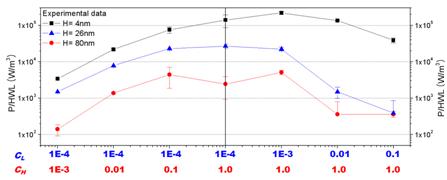
Schematic Diagram of Power Generation
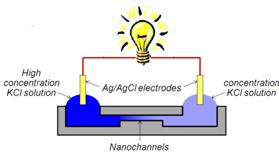
Finished Project IV: Ion Transport in 1-D confined 2-nm Nanochannels
Tr
Ref: C. Duan and A. Majumdar, “Anomalous Ion Transport in 2-nm Hydrophilic Nanochannels”, Nature Nanotechnology, vol. 5, pp. 848-852, (2010).
Finished Project V: Evaporation Induced Cavitation in Nanochannels
Ca
Ref: C. Duan, R. Karnik, M. Lu and A. Majumdar, “Evaporation Induced Cavitation in Nanofluidic Channels”, PNAS, 2012 .
Finished Project VI: Ion Transport in Graphene Nanofluidic Channels
Ca
Ref: Q. Xie, F. Xin, HG. Park, C. Duan#, “Ion transport in graphene nanofluidic channels”, Nanoscale, vol. 8, pp 19527-19535, (2016).
Finished Project VII: Water Drying in Nanochannels
李
Ref: Q. Xie, S. Xiao, C. Duan#, “Geometric Dependent Drying in Dead-End Nanochannels.” Langmuir, 33 (34), pp 8395–8403, (2017).
Finished Project VIII: Water Evaporation in hybrid-Nanochannels
Ca
Ref:
- Y. Li, M. A. Alibakhshi, Y. Zhao, and C. Duan#, “Exploring Ultimate Water Capillary Evaporation in Nanoscale Conduits”, Nano Lett., 17 (8), pp 4813–4819, (2017).
- M. A. Alibakhshi, Q. Xie, Y. Li, and C. Duan#, “Accurate Measurement of Liquid Transport through Nanoscale Conduits”, Scientific Reports, 6, (2016).
Finished Project IX: Single Bubble Dynamics on Superheated Superhydrophobic Surfaces
Th
Ref:
- Y. Li, K. Zhang, MC. Lu, C. Duan#, “Single bubble dynamics on superheated superhydrophobic surfaces”, International Journal of Heat and Mass Transfer, vol. 99, pp 521-531, (2016).
- Y. Li, C. Duan#, ”Bubble-Regulated Silicon Nanowire Synthesis on Micro-Structured Surfaces by Metal-Assisted Chemical Etching”, Langmuir, vol. 31 , pp. 12291-12299, (2015).



